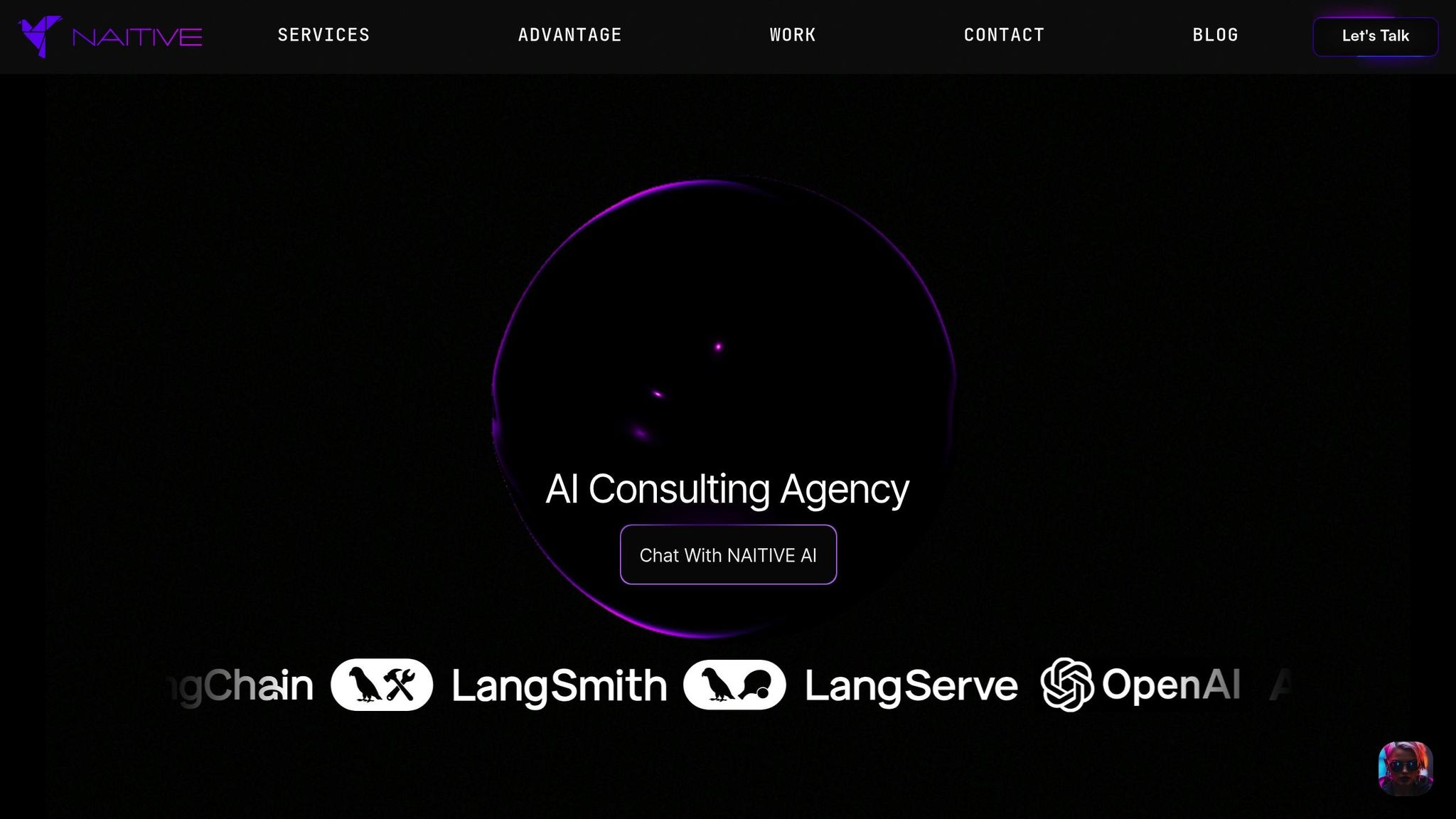Checklist for AI-Driven Leadership Models
Explore essential strategies for AI-driven leadership, focusing on readiness, ethical use, and continuous improvement for better decision-making.

AI is reshaping leadership by transforming decision-making, efficiency, and organizational strategies. With 82% of executives expecting AI to significantly impact their businesses, leaders must integrate AI tools to stay competitive. Here's what you need to know:
- AI's Impact: Boosts efficiency (e.g., 67% cost reduction in business processes) and drives growth (71% revenue increase in marketing/sales functions).
- Leadership Readiness: Only 1% of leaders consider their organizations mature in AI use. Address skill gaps, align AI with goals, and engage employees to overcome resistance.
- Technology & Data: Strong infrastructure is vital. Evaluate data quality, system scalability, and network capabilities to support AI at scale.
- Ethical AI: Transparency, bias audits, and clear guidelines are critical to ensure fair and responsible AI use.
- Continuous Improvement: Use feedback loops, track KPIs, and refine systems to keep AI aligned with evolving business needs.
AI-driven leadership requires preparation, execution, and consistent refinement. Organizations ready to embrace this shift can improve decision-making, optimize resources, and enhance customer experiences while addressing ethical concerns.
How Leaders Could Use AI To Make Better Decisions
Checking If Your Organization Is Ready for AI Leadership
Before jumping into AI implementation, it's crucial to take a step back and assess whether your organization is truly prepared to succeed. Only 1% of leaders describe their companies as "mature" in terms of AI deployment, while nearly half (47%) of C-suite executives admit their organizations are moving too slowly in developing and releasing generative AI tools.
This gap in readiness isn’t just about technology. It involves leadership skills, infrastructure, and company culture. By carefully evaluating these three areas, you can pinpoint where your organization stands and what needs to be addressed before taking the next steps.
Review Leadership and Team Skills
The readiness of your leadership team plays a key role in ensuring AI technology aligns with your strategic goals. But many organizations face a major hurdle: skill gaps are a leading reason for the slow adoption of generative AI tools.
Leaders must understand how AI complements human creativity, decision-making, and innovation. This perspective is essential for fostering a workplace where AI is seen as an ally, not a threat. Midlevel managers, in particular, are vital to integrating AI into daily workflows and bridging the gap between high-level strategies and on-the-ground execution. However, they’re often overlooked in readiness evaluations.
To address this, consider implementing structured development programs that focus on building foundational AI knowledge, cultivating an "AI-first" mindset, and equipping leaders to guide AI initiatives. Without strong leadership, even the best AI tools may fail to deliver meaningful results.
Additionally, listen to your employees. How are they currently using AI? How do they see it reshaping their roles? Leaders who engage with these perspectives can better support the transition and identify opportunities for improvement. This empathetic approach is key to overcoming resistance to change.
Check Technology and Data Systems
Your organization's technology infrastructure is the backbone of any AI initiative. According to recent surveys, 43% of C-level technology executives have growing concerns about their infrastructure’s ability to support generative AI. Many are now focused on upgrading systems to handle AI at scale.
Start by evaluating your data architecture. AI systems rely on high-quality, easily accessible data. If your data is scattered, inconsistent, or hard to retrieve, AI implementation will face significant challenges.
Next, ensure your technology aligns with AI best practices and supports your planned initiatives. Key areas to assess include:
- Power and cooling capacity
- Network infrastructure for handling large data volumes
- Optimized storage and processing capabilities
- Strong security measures for scalability
Network infrastructure is especially critical. Studies show that network costs account for 44% of total spending on generative AI training. With 30% of organizations planning to deploy AI in hybrid cloud environments, modernizing connectivity is essential.
| Infrastructure Layer | Key Technologies to Evaluate |
|---|---|
| Data Management | Kafka, Hadoop, Cassandra, S3 |
| Processing & Analytics | Spark, Flink, Hadoop MapReduce |
| Machine Learning | TensorFlow, PyTorch, Scikit-learn |
| Security & Compliance | RBAC, IAM, Encryption at rest & in transit |
Finally, review your data centers for capacity, scalability, and security. A robust technology foundation ensures your organization can scale its AI ambitions effectively.
Measure Culture and Change Readiness
An organization's culture often determines whether AI initiatives succeed or fail. In the U.S., only 15% of employees believe their company has communicated a clear AI strategy, and just 11% feel "very prepared" to work with AI technologies.
Organizations that embrace continuous learning and see AI as a tool for enhancement - not replacement - tend to achieve better results. A culture that encourages experimentation and accepts failure as part of the process is better equipped to adapt to AI-driven changes.
The World Economic Forum estimates that by 2030, 70% of the skills required for most jobs will have changed. Companies with learning-focused cultures are more likely to navigate this transformation successfully. Assess whether your employees actively pursue new skills and whether leadership supports their growth.
Transparent communication is another key factor. While 80% of C-suite executives believe AI will spark a cultural shift toward greater innovation, fewer than half involve nontechnical employees in the early stages of AI tool design. This disconnect can hinder adoption.
Dan Shapero, COO of LinkedIn, highlights the scale of this challenge:
"With this change, executives know they need to disrupt how their teams get work done. We are entering one of the largest change management exercises in history, and every business leader and professional will need to embrace it in order to unlock the value of AI."
Examine whether your organization rewards initiative and supports change. According to a Harvard Business Impact study, 40% of senior leaders say their companies are prioritizing change-ready cultures, and 71% now view the ability to lead through constant change as critical.
To ensure a smooth transition, address employee concerns directly. Establish clear ethical guidelines for AI use, and provide comprehensive training to build AI fluency across all levels. A culture that supports change and values its people will be better positioned to turn AI investments into real business outcomes.
Setting Up AI-Driven Decision-Making Models
Turning readiness into action is crucial for leveraging AI in decision-making. While 84% of executives acknowledge that scaling AI is essential for strategic growth, only 16% have moved beyond the experimental stage. This gap often boils down to challenges in planning and execution.
To bridge this divide, start with a structured framework that prioritizes clear planning and effective implementation.
Create an AI Implementation Plan
An AI implementation plan acts as your blueprint for weaving artificial intelligence into leadership decisions. Begin by setting specific, measurable goals - such as reducing budget approval timelines by 40% within six months using predictive analytics.
Data quality is non-negotiable. Ensure your data is accurate, complete, and consistent because even the most advanced AI systems falter with flawed inputs. Alongside this, assemble a team that includes data scientists, machine learning experts, and professionals who deeply understand your industry.
A culture of continuous learning is equally important. Build risk management and ethical guidelines into your plan from the start, focusing on rigorous evaluations and safeguarding data privacy. Finally, consider scalability - choose infrastructures and systems that can grow alongside your organization’s evolving needs.
Choose the Right AI Tools and Solutions
Picking the right AI tools is a strategic decision that directly impacts your outcomes. Evaluate solutions based on their expertise, privacy features, cost, support, technical compatibility, alignment with business goals, and risk management.
Ensure the tools integrate seamlessly with your current systems, can scale with your growth, and handle data effectively. Additionally, the tools should address ethical concerns like bias mitigation and privacy protection while delivering measurable returns. For instance, McKinsey and PwC project that AI could add $13–15 trillion to global GDP by 2030, highlighting how informed technology choices can drive significant value.
Once you’ve selected the tools, validate them with pilot programs to ensure they meet your needs in real-world scenarios.
Run AI Pilot Programs
Pilot programs allow you to test your AI plans in controlled, practical settings. As Travis Gibson, Chief Technology Officer at Big Brothers Big Sisters of America, puts it:
"Start with the problem, not the technology."
Focus on learning rather than immediate success. For example, Big Brothers Big Sisters of America piloted an AI agent to analyze data and suggest 8–10 potential matches between adults ("Bigs") and young people ("Littles"), with human specialists making the final decisions. Similarly, Engine, a business travel management platform, introduced an AI agent named Eva to handle customer reservation cancellations. Eva now manages 30–40 cancellations weekly and has expanded her role to address FAQs.
Involve stakeholders early, adopt an iterative approach, and provide regular updates. Document the results, identify emerging strengths, and refine your approach based on feedback. This process ensures that your AI initiatives remain adaptable and effective.
Tracking and Improving AI Leadership Models
Achieving success with AI-driven leadership isn’t a one-and-done deal. It’s an ongoing process that requires consistent monitoring and adjustments. Organizations that treat AI as a static solution often find their systems out of sync with changing business demands. By building on readiness and implementation strategies, tracking progress ensures that AI leadership stays aligned with organizational goals.
Set Success Metrics and KPIs
To truly evaluate the impact of AI leadership, you need clear, measurable goals. Without defined metrics, it’s impossible to gauge the value AI brings to the table. Start by identifying specific, quantifiable outcomes that directly tie to your business objectives. For example, if your AI initiative aims to speed up approval processes, track metrics like decision speed, accuracy, and cost savings.
Look at both financial and operational metrics. Financially, consider return on investment (ROI) based on benefits like increased efficiency or fewer errors. Operationally, focus on metrics such as process completion times and resource usage. Don’t forget to measure user adoption - track how often the system is used, which features are engaged, and overall satisfaction levels. Dashboards offering real-time insights can help leadership quickly spot trends and fine-tune strategies. Regular reporting - monthly or quarterly - keeps AI performance a priority.
As you track progress, it’s equally important to align these metrics with ethical standards to maintain trust among stakeholders.
Maintain Ethical AI Usage
Using AI ethically isn’t just about doing the right thing - it’s also about protecting your organization from reputational and regulatory risks. Transparency is key. Everyone involved, from team members to stakeholders, should understand how AI systems make decisions, the data they rely on, and the potential consequences of those decisions. Adopting explainable AI models is especially critical in high-stakes areas like hiring or resource allocation.
Bias is another major concern. AI can unintentionally reinforce existing biases, leading to unfair outcomes. Regular audits can help uncover and address these issues before they escalate.
Consider forming an ethical oversight board with representatives from diverse backgrounds within your organization. This group can review AI decisions, assess risks, and provide guidance on complex ethical challenges. Additionally, strong data governance policies are essential. These should include strict controls over data collection, storage, and usage, along with regular audits to protect personal information and prevent privacy violations.
Here’s a quick checklist to guide ethical AI practices:
| Ethical AI Do's | Ethical AI Don'ts |
|---|---|
| Ensure transparency in decision-making | Ignore potential algorithm biases |
| Involve diverse stakeholders in development | Leave ethics solely to technical teams |
| Regularly audit for compliance | Assume ethical issues will fix themselves |
| Follow established ethical guidelines | Overlook user privacy concerns |
| Educate teams on ethical practices | Prioritize short-term gains over long-term trust |
Ethics should be woven into every step of AI development and refinement.
Use Feedback for Continuous Improvement
Feedback is what transforms AI systems into evolving, valuable tools. The best AI strategies include structured feedback loops that draw insights from users, stakeholders, and performance data.
Host regular team discussions to identify what’s working and what needs improvement. Go beyond simple satisfaction surveys - dig into specific use cases, workflow challenges, and decision-making adjustments.
Don’t stop at internal feedback. Reach out to customers, partners, and other external stakeholders affected by AI-driven decisions. For instance, if your AI system is part of customer service, regularly gather feedback to ensure it’s enhancing the overall experience.
Leverage performance reviews and post-implementation analyses to uncover patterns or areas needing extra training or support. While AI offers data-driven recommendations, human oversight remains essential. By continuously iterating based on comprehensive feedback, your organization can keep its AI strategy relevant and effective in meeting evolving business needs.
Conclusion: Building Future-Ready AI Leadership
AI-driven leadership is reshaping how decisions are made, performance is evaluated, and challenges are navigated. As we've seen throughout this checklist, thriving in this landscape requires a thoughtful approach that blends preparation, execution, and ongoing refinement. Let’s revisit some key points from our discussion.
Key Takeaways
The journey to effective AI leadership starts with a clear-eyed evaluation of your team's skills, available technology, and workplace culture. This groundwork is critical for ensuring that AI initiatives don’t falter before they even begin.
When it comes to implementation, success hinges on strategic alignment. Companies that define precise business objectives and integrate AI into their broader corporate goals achieve far better outcomes. There’s no shortage of evidence - leading organizations are already using AI to optimize key performance metrics.
Ethics must remain a cornerstone of AI leadership. The potential impact is enormous: AI could replace half of all entry-level white-collar jobs within just five years. Leaders who prioritize transparency, fairness, and accountability not only safeguard their reputation but also gain an edge in competitive markets. As Michael Impink from Harvard DCE observes:
"If it becomes commonplace to use AI, the firms who use it ethically and responsibly will gain a competitive advantage. The ones who don't might have a harder time winning contracts or accessing data."
Sustained success requires continuous improvement. This includes creating feedback loops, tracking performance, and staying flexible as AI technology evolves.
The numbers tell a compelling story. Between 2024 and 2025, the percentage of organizations experimenting with or adopting AI for leadership development rose by 12%. Yet, only 34% of managers are leveraging AI to develop new KPIs, despite 60% acknowledging the need to enhance their measurement systems. This gap highlights both a challenge and an opportunity for leaders ready to embrace change.
These insights underscore the critical role of preparation, strategic thinking, and ethical execution in building AI-driven leadership that works.
How NAITIVE AI Consulting Agency Can Help

Turning these insights into actionable strategies often requires expert guidance. That’s where NAITIVE AI Consulting Agency comes in. Their team specializes in creating autonomous AI systems that integrate seamlessly into your existing workflows and scale alongside your business.
NAITIVE’s process goes beyond just deploying technology. They focus on designing automation systems tailored to your organization’s specific needs, combining cutting-edge AI tools with practical business strategies to deliver measurable outcomes.
Whether you're just starting to explore AI-driven leadership or looking to refine your current systems, NAITIVE offers end-to-end consulting services. From initial assessments and strategy development to implementation and ongoing optimization, their approach ensures every step delivers value.
Ready to revolutionize your leadership approach? NAITIVE’s team of experts is here to help you build leadership models that are not just AI-powered but also future-ready, ensuring your organization stays ahead in an increasingly AI-driven world.
FAQs
What steps can leaders take to close skill gaps and effectively integrate AI into their business strategies?
To bridge skill gaps and effectively incorporate AI, leaders should prioritize upskilling and reskilling programs focused on AI knowledge and practical use. These initiatives can pinpoint areas where skills need improvement, helping leaders build the expertise required to make smart, data-informed decisions.
Equally important is cultivating a mindset of continuous learning. Leadership development should highlight the importance of understanding AI's ethical considerations, using data to guide decisions, and embracing forward-thinking approaches. By focusing on these areas, organizations can prepare leaders to integrate AI into their strategies with confidence and responsibility.
What steps can organizations take to ensure AI is used ethically and responsibly?
To make sure AI is developed and used responsibly, organizations need clear guidelines that focus on transparency, accountability, and fairness. This includes setting up ethics committees, training both leaders and employees on AI-related principles, and crafting policies that uphold human rights and prioritize safety.
On top of that, regular monitoring, using transparent algorithms, and enforcing strict data privacy measures are essential. These steps not only help reduce risks but also build trust, creating a solid framework for ethical AI practices that stakeholders can rely on.
How can businesses evaluate the success of AI-driven leadership models and ensure they stay relevant to changing organizational goals?
Businesses can gauge the effectiveness of AI-driven leadership models by evaluating key outcomes such as return on investment (ROI), operational efficiency, and how well AI integrates into strategic decision-making. Metrics like improved productivity, reduced costs, or better decision-making processes can serve as clear indicators of success.
To keep these models aligned with shifting objectives, companies should focus on continuous learning and flexibility. This means regularly revisiting AI strategies, updating them to match market developments, and nurturing a workplace culture that values innovation and adaptability. These efforts help ensure AI leadership models remain relevant and capable of addressing both present and future challenges.




